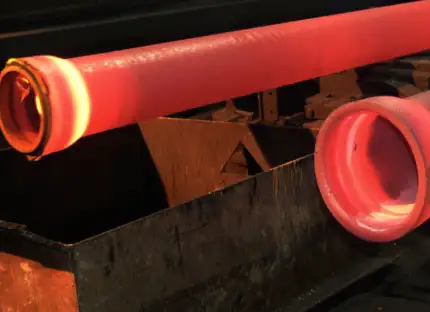65-45-12 ductile iron, conforming to ASTM A536, is a widely used engineering material known for its excellent machinability, strength, and versatility. Its composition, characterized by nodular graphite in a ferritic matrix with small amounts of pearlite, contributes to its favorable machining characteristics. Understanding the machinability of 65-45-12 is crucial for optimizing machining processes and achieving high-quality finished components.

1. Understanding the Composition and Microstructure
The microstructure of 65-45-12 ductile iron plays a significant role in its machinability. The nodular graphite structure provides self-lubricating properties, reducing tool wear and improving surface finish. The ferritic matrix offers good ductility and impact resistance, while the small amounts of pearlite enhance strength. This combination results in a material that is both machinable and durable.
2. Machining Characteristics
-
Cutting Speeds and Feed Rates: Recommended cutting speeds for 65-45-12 ductile iron range from 800 to 1,000 surface feet per minute (sfm) for rough turning and 1,200 to 1,500 sfm for finish turning. Feed rates should be between 0.014 and 0.028 inches per revolution (ipr) for rough turning and 0.004 to 0.020 ipr for finish turning. Drilling and milling operations typically use cutting speeds between 475 and 825 sfm with feed rates of 0.004 to 0.012 ipr.
-
Tool Selection: High-speed steel (HSS) and carbide tools are commonly used for machining 65-45-12 ductile iron. Carbide tools are preferred for higher production rates due to their wear resistance. Coated tools can further enhance tool life and performance.
-
Coolant Use: Using appropriate coolant is essential to dissipate heat, reduce tool wear, and improve surface finish. Water-soluble oils or synthetic coolants are commonly used.
3. Comparison with Other Ductile Iron Grades
| Grade | Tensile Strength (ksi) | Yield Strength (ksi) | Elongation (%) | Hardness (BHN) | Machinability Rating |
|---|---|---|---|---|---|
| 65-45-12 | 65 | 45 | 12 | 156–217 | Excellent |
| 60-40-18 | 60 | 40 | 18 | 160–210 | Good |
| 80-55-06 | 80 | 55 | 6 | 200–250 | Moderate |
This comparison highlights the superior machinability of 65-45-12 ductile iron, making it a preferred choice for many applications.
4. Heat Treatment Effects on Machinability
Heat treatment processes such as annealing can soften 65-45-12 ductile iron, improving its machinability. However, excessive heat treatment can lead to a reduction in strength and hardness. Therefore, it’s essential to balance heat treatment parameters to maintain the desired mechanical properties while optimizing machinability.
5. Common Machining Challenges and Solutions
-
Tool Wear: Excessive tool wear can result from high cutting speeds and feed rates. Using coated carbide tools and maintaining optimal cutting parameters can mitigate this issue.
-
Surface Finish: Achieving a smooth surface finish requires proper coolant application and maintaining consistent cutting conditions.
-
Chip Control: Long, stringy chips can cause machine jams and poor surface finish. Using chip breakers and optimizing feed rates can help manage chip formation.
6. Applications Benefiting from Excellent Machinability
Components such as gears, cylinder blocks, manifolds, and valve bodies benefit from the excellent machinability of 65-45-12 ductile iron. Its ability to be easily machined into complex shapes reduces manufacturing time and costs, making it ideal for high-volume production.
7. Frequently Asked Questions (FAQs)
Q1: What is the optimal cutting speed for machining 65-45-12 ductile iron?
The optimal cutting speed varies depending on the machining operation. For rough turning, a cutting speed of 800 to 1,000 sfm is recommended, while for finish turning, 1,200 to 1,500 sfm is preferred. Drilling and milling operations typically use cutting speeds between 475 and 825 sfm.
Q2: Can 65-45-12 ductile iron be machined without coolant?
While it’s possible to machine 65-45-12 ductile iron without coolant, using coolant is recommended to dissipate heat, reduce tool wear, and improve surface finish. Water-soluble oils or synthetic coolants are commonly used.
Q3: How does the machinability of 65-45-12 compare to other materials?
65-45-12 ductile iron offers superior machinability compared to many other materials, including steel. Its nodular graphite structure provides self-lubricating properties, reducing tool wear and improving surface finish.
Q4: What are the common machining operations for 65-45-12 ductile iron?
Common machining operations for 65-45-12 ductile iron include turning, milling, drilling, and tapping. Its excellent machinability allows for these operations to be performed efficiently and with high precision.
Q5: Are there any special considerations when machining 65-45-12 ductile iron?
While 65-45-12 ductile iron is highly machinable, it’s essential to use appropriate cutting parameters, select the right tools, and apply coolant to achieve optimal results. Regular tool maintenance and monitoring of machining conditions can also help maintain quality and efficiency.
Q6: What industries commonly use 65-45-12 ductile iron?
Industries such as automotive, fluid power, machinery, and construction commonly use 65-45-12 ductile iron for components like gears, cylinder blocks, manifolds, and valve bodies. Its excellent machinability and mechanical properties make it suitable for a wide range of applications.
Conclusion
65-45-12 ductile iron’s exceptional machinability makes it a preferred material for various engineering applications. By understanding its composition, machining characteristics, and best practices, manufacturers can optimize their machining processes to achieve high-quality components efficiently.

